Wind Turbine Colour - Windmill Painting
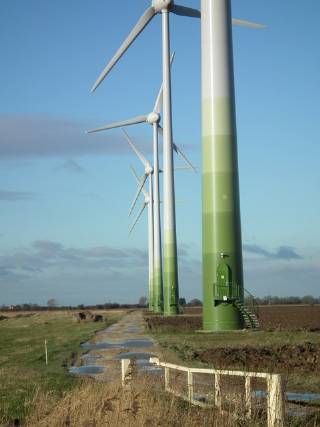
Selecting the most appropriate colour for a turbine(s) is an important part of detailed windfarm design and mitigation. It has previously been assumed that wind turbines could be painted a colour that would camouflage them against their background. Experience has shown that it is not possible to ‘hide’ turbines. There are a large number of variables which affect visibility of wind turbines.
These include:
–the immediate landscape context and anticipated backcloth against which the turbines will be viewed predominantly (for example sky, heather moorland, woodland, sea horizon). Colour contrast is an important factor affecting visibility. Generally, the base of a turbine is seen against the land and the tower and moving blades seen against the sky, so colour choice will inevitably be a compromise between reducing contrast with the land or with the sky;
–the direction the turbines will most frequently be viewed from (including the angle of the sun and how it is likely to reflect on the wind turbines);
–the predominant weather conditions (which will dictate typical sky colour and will vary for different parts of the country);
–seasonal variation in landscape colours;
–the number and type of viewer (e.g. resident, worker, recreational)and the nature of the viewpoint;
–distance from the development. Colour is most apparent in close views, and in these situations turbines are most likely to be viewed against the sky;
–the proposed design and layout of the windfarm; and other windfarms within the area.
Colour choice is therefore likely to be an ‘on-balance’ judgement based on a clear design objective or objectives, in order for these to be tested. Examples of design objectives may include:
-reduce visual impacts;
-camouflage;
-integrate with the landscape;
-reinforce local identity;
-reduce cumulative effects; or
-make a statement.
When dealing with a situation where a large number of variables exist, it is important to focus on one or two key design objectives.
As a general rule for m
ost rural areas of Scotland:
–a single colour of turbine is generally preferable;
–the use of graded colours at the turbine base should be avoided as public perception studies have demonstrated that aesthetic unity is viewed favourably. Therefore graduated schemes, or turbines with colour variation, should be used with caution;
–a light grey colour generally achieves the best balance between reducing visibility and visual impacts when seen against the sky, although this works less well when viewed against the land;
–the use of coloured turbines (such as greens, browns or ochres) in an attempt to disguise wind turbines against a landscape backcloth is usually unsuccessful although variation from the standard light grey colour may be successful when the wind farm is backclothed from important viewpoints or receptors. The chosen turbine colour should respond to the character of the site and its setting;
-light coloured turbines seen against a land backdrop may have greater prominence than light or dark turbines seen against the sky;
-there is more scope to vary the colour of smaller turbines, which are often located on lower ground than larger turbines, and therefore more often backclothed by land;
–paint reflection should be minimised. Texture is an important factor in reducing reflectivity, and matt or light absorbent finishes are preferable;
–for multiple wind farm groups or wind farm extensions, cumulative colour effects will be a key consideration.Astrategic approach to turbine colour
is desirable and the colour of turbines should generally be consistent;
–precise colour tone and the degree of paint reflectivity should be specified at the application stage. Commercial implications may be a limitation to varying turbine colour on a commercial scale, including cost, availability, lead
-in-time and weathering/fading;
-colour may be subject to aviation restrictions or,for off
-shore turbines, navigational requirements. For example it is a navigational safety requirement for the base of off
-shore turbines to be coloured bright yellow for 25 metres above sea level.
Labels
Wind Turbine Colourhow to make a wind turbineuses of wind energywhat is wind energyelectric windmillsenergy windmillsuses of windmillpainted windmillsoffshore wind farmused wind turbineswindmill paintingFarming Principle: Deep Soil Preparation
Looking at GB as a three-legged stool, deep soil preparation is one of the legs. Deep soil preparation builds soil and soil structure by loosening the soil to a depth of 24 inches (60 cm). Ideal soil structure has both pore space for air and water to move freely and soil particles that hold together nicely.

Smart Home Ecosystem - Smart Home Automation - Smart Home Security - Smart Home Technology
The outer-most level corresponds to the individual devices and sensors that consumers interact with. Several candidates are vying for the role of a leader introducing smart home services to the mass market.

Solar Energy Systems - Solar Modules - Solar Electric System Design - Solar Power
The heart of a photovoltaic system is the solar module. Many photovoltaic cells are wired together by the manufacturer to produce a solar module. When installed at a site, solar modules are wired together in series to form strings. Strings of modules are connected in parallel to form an array.
Solar Energy Systems - Array Mounting Racks - Solar Ray - Solar Panel - PV Racks and Mounts
Arrays are most commonly mounted on roofs or on steel poles set in concrete. In certain applications, they may be mounted at ground level or on building walls. Solar modules can also be mounted to serve as part or all of a shade structure such as a patio cover. On roof-mounted systems, the PV array is typically mounted on fixed racks, parallel to t

Solar Energy Systems - Grounding Equipment
Grounding equipment provides a well-defined, low-resistance path from your system to the ground to protect your system from current surges from lightning strikes or equipment malfunctions. Grounding also stabilizes voltages and provides a common reference point. The grounding harness is usually located on the roof.
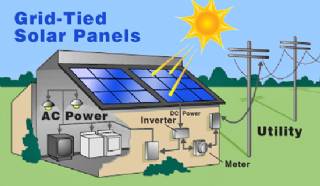
Solar Energy Systems - Solar Inverter - Solar Panel Inverter
Most grid-connected inverters can be installed outdoors, while most off-grid inverters are not weatherproof. There are essentially two types of grid-interactive inverters: those designed for use with batteries and those designed for a system without batteries.
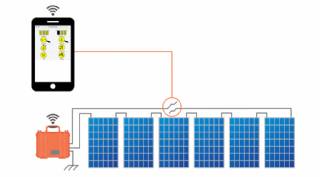
Solar Energy Systems - Solar Disconnects
Automatic and manual safety disconnects protect the wiring and components from power surges and other equipment malfunctions. They also ensure the system can be safely shut down and system components can be removed for maintenance and repair.
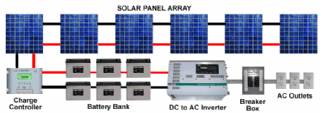
Solar Energy Systems - Solar Battery Bank
Batteries store direct current electrical energy for later use. This energy storage comes at a cost, however, since batteries reduce the efficiency and output of the PV system, typically by about 10 percent for lead-acid batteries. Batteries also increase the complexity and cost of the system.

Solar Energy Systems - Solar Charge Controller
A charge controller, sometimes referred to as a photovoltaic controller or battery charger, is only necessary in systems with battery back-up. The primary function of a charge controller is to prevent overcharging of the batteries. Most also include a lowvoltage disconnect that prevents over-discharging batteries. In addition, charge controllers pr
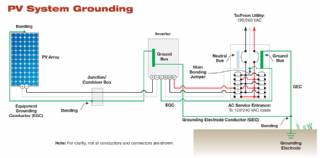
Solar Energy Systems - The NEC and PV Systems
Solar PV systems must be installed in accordance with Article 690 of the National Electric Code, which specifically deals with PV systems, as well as several other articles of the NEC that pertain to electrical systems in general. When there is a conflict between NEC 690 and any other article, NEC 690 takes precedence due to the unique nature of PV